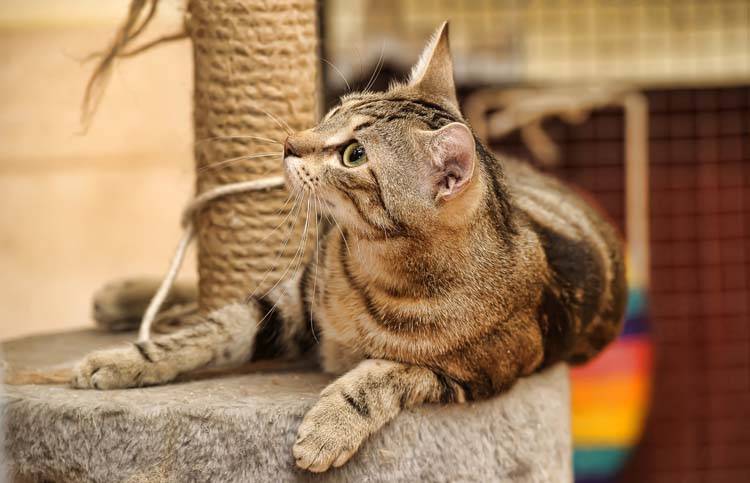Enriching Your Indoor Cat’s Life
Now that the weather is cooler, more of the indoor-and-outdoor cats are becoming indoor-only cats. Most veterinary assistants agree keeping your cat indoors is the preferred choice regardless of weather. This lessens the chance of encountering injury or disease. It can also provide your cat an enriched environment, which helps minimize boredom, keeps him physically fit and can reduce or even eliminate some unwanted behaviors.
Some Basic Requirements
Sure, we know that food and water are the basics for all living creatures so that’s a given. Of course, you will want to have a litter box as well. Additional things that cats need to enhance their indoor experience and allow them to perform their natural behaviors are a scratching post and toys. They also need their own personal space.
Food and Water
Since cats are solitary hunters, it’s preferable to place their food and water in a location where loud noises won’t travel (on the washing machine during the spin cycle is not recommended!). Also, place your cat’s food in an area sheltered from regular household traffic; a place where he’ll feel safe eating. Keep in mind, the cat’s litter box shouldn’t be nearby either.
Many cats enjoy a bit of running water either from the sink or a bowl that circulates the water. Obtaining water this way can be more stimulating than a regular bowl. Cat grass is something that can enrich your indoor cat’s munchies cravings. Cats will chew on a bit of grass when allowed outdoors and cat-appropriate indoor grass will bring some of that outdoor fun inside!
You can enrich your little hunter’s dinnertime by simulating the hunt. There are commercially made toys that you can place either a bit of moist food or treats in so your cat can stalk its “prey.” He has to interact with the prey toy and the food will be released. Not only does this satisfy his inner lion, but it helps him stay active as well.
RELATED: Keeping Indoor Cats Properly Exercised
Living Space (and Personal Space)
Cats tend not to have a social hierarchy like dogs do. If you have multiple animals, it’s important to provide each animal with his own space. Small adjustments to your household environment like having beds in multiple spots or clearing perches for your cat (even an empty spot on the window sill will work) provides opportunities for the cat to disengage with the household and have some quiet time to himself.
Scratching Posts
One natural cat behavior (that drives their humans crazy!) is scratching. In the wild, scratching not only maintains the health of their claws, but it also leaves behind pheromones as well as visible claw marks to alert other cats they’ve been there.
Vertical scratching posts work well, as this is the natural position that many cats prefer (think of those trees). Commercial scratching posts generally have carpet, but many cats prefer natural sisal. Sisal is from the agave plant that yields a fibrous material often used to make rope, dartboards and other similar items. Sisal allows the cats to really sink their claws in.
Other substances that cats enjoy are cardboard scratchers. While some cats will take right to these, many owners have a complaint that their cats won’t even look sideways at the post. Watch how and where your cat tends to scratch. Does he prefer to stretch up? If you notice that he does, then a vertical post will be more appealing (especially with a bit of cat nip application).
The scratching behavior ties into territory marking so positioning these posts in the location where the cat tends to frequent will increase usage. If your cat spends most of his time in the spare bedroom, then position the post there. If most of his time is spent on the couch, place one in very close proximity.
RELATED: Inappropriate Urination in Cats
Toys
As we’ve established, cats are predators and they require prey in order to keep the mind satisfied. Natural hunting behaviors include stalking, pouncing, jumping, biting and chasing, which are all the things that humans do not appreciate much, especially at 2 a.m.! However, understand that cats need to do this as it is instinctual.
When engaging in play with your cat, discourage him from using you as the toy. Do not let him bite your hands or feet. This may lead to play-related aggression issues later on. More appropriate toys would be something like a battery-operated toy that moves on its own to encourage pouncing. Cat nip-filled toys are often lightweight, allowing the cat to toss the toy around and catch it, enacting a natural behavior if he had caught a small rodent. Other great toys that you can interact with your cat are the light beam toys (hours of chasing and jumping) or toys at the end of poles (like those feathers or wands).
Providing an enriched indoor environment for your feline will combat boredom while keeping your cat more active. Indoor enrichment can also improve unwanted behaviors, such as excessive vocalizing or aggression.
If you are experiencing any behavioral problems with your cat, it’s recommended to make an appointment with your veterinarian to discuss the behavior and ensure there isn’t a hidden health issue before focusing on behavior modification. Your veterinary assistant can also review what enrichment strategies you’ve been utilizing and offer further advice. By working together with your veterinary team, you can provide your cat a fulfilling indoor lifestyle.
You may also like: How to Make Your Cat a Happy One





